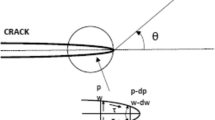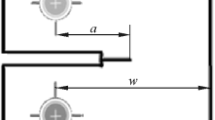Abstract
On condition that any perfectly plastic stress component near a singular point is nothing but the function of θ only, making use of equilibrium equations and Hill anisotropic yield condition, we derive the general analytical expressions of the anisotropic plastic stress field near a singular point in both the cases of anti-plane and in-plane strains. Applying these general analytical expressions to the concrete cracks and the plane-strain bodies with a singular point, the anisotropic plastic stress fields at the tips of Mode I, Mode II, Mode III and mixed mode I–II cracks, and the limit loads of anisotropic plastic plane-strain bodies with a singular point are obtained.
Similar content being viewed by others
References
Lin Bai-song, Perfectly plastic stress fields at a stationary crack tip,Applied Mathematics and Mechanics,6, 5 (1985), 431 - 438.
Lin Bai-song, Elastic perfectly-plastic fields at a rapidly propagating crack-tip,Applied Mathematics and Mechanics,6, 10 (1985), 1017 - 1025.
Hill, R.,The Mathematical Theory of Plasticity, Oxford (1950).
Kachanov, L.M.,Foundation of the Theory of Plasticity, London (1971).
Author information
Authors and Affiliations
Additional information
Communicated by Chien Wei-zang
Rights and permissions
About this article
Cite this article
Bai-song, L. Anisotropic plastic stress field near a singular point. Appl Math Mech 8, 767–772 (1987). https://doi.org/10.1007/BF02017984
Received:
Issue Date:
DOI: https://doi.org/10.1007/BF02017984




